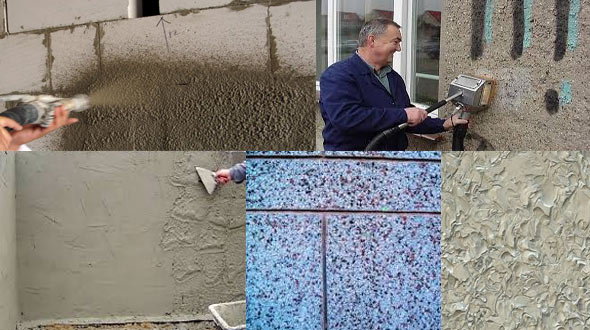Different types of plastering for construction work
- Concrete Cost Estimator
- Concrete Continuous Footing
- Landscape Bidding and Estimating
- Construction Cost Estimating
- Concrete and steel cost estimation
- Construction Cost Estimate Breakdown
- Construction Estimating Worksheet
- Home Construction Cost Estimate
- Estimate Pricing Sheet
- Sheet for General Contractor
- Construction Cost Estimate
- Labor Materials Cost Estimator
- Masonry Estimating Sheet
- Sheet for Building Contractor
- Construction Schedule Bar chart
- General Cost Estimator Sheet
- General Construction Estimate
- Building and Road Estimating Sheet
- Detailed expense estimates
- Door and Window Takeoff Sheet
- General Construction Cost Estimating Sheet

Given below, the detail lists of various types of plastering for construction work
1. Sand faced plaster:
• The first coat of sand faced cement plaster is applied with cement mortar in 1:4 ratio containing coarse sand after curing the plaster for seven days the second coat of cement plaster 1:3 ratio will be applied on the first coat.
• In the second coat sponge is applied when the second coat gets drenched. It is done in such a way that the density of sand grain is visible on surface is equivalent and consistent.
• The surface should be perfectly drenched with water minimum for 15 days.
2. Rough Cast Plaster:
• This plaster formed by blending sand and gravel in particular proportion dashed over a newly plastered surface.
• The plaster base comprises of two coats, under layer 12 mm compact and top layer 10 mm compact containing the cement mortar ratio 1:3.
• To make the base more flexible, approx 10% of hydrated lime by volume of cement should be included at the time of forming mortar.
3.Pebbled dash plaster:
• It is equivalent to rough cast finish apart from clean pebble of size ranging from 6 mm to 12.5 mm are dashed against the surface in order that the position is set by mortar used already.
4. Smooth cast plaster or plain face plaster:
• This finish has similarity with sand faced finish apart from fine grained sand is utilized in spite of coarse sand.
• No sponging is accomplished for the exposure of the sand grain.
• It is generally provided on internal walls.
5. De peter Plaster:
• It is another form of rough cast finish.
• The rendering coat of 12 mm thick is made as in case of pebbled dash finish.
• As this coat is wet, pieces of gravel are pressed manually on the surface.
• So, it becomes easier to create good looking patterns and ornamental designs on the surface by choosing materials of diverse colors.
6.Washed stone Grit Plaster:
• This plaster is provided in two layers, under layer 12 mm cement plaster in 1: 4 ratio.
• It is corrugating the under layer with scratching tools using cement slurry on the under layer at the rate 2 Kg. cement per SQM and on the top layer 1d5 mm cement plaster 1:0.5: 2 ( 1 cement : 0.5 coarse sand : 2 stone chipping 10 MM nominal size. ) in panels containing groove all around according to sanctioned pattern inclusive of washing the top layer with brushes and water to expose the stone chipping .
7. Plastering with terrazzo finish:
• This plastering is generally 18 mm --------- having Terrazzo finish, rubbed and polished under layer 12mm thick plaster 1:3 and top of 6 mm thick white, black, chocolate l, gray , yellow or green marble chips of 3 mm laid in cement marble powder mix 3:1 by weight in proportion 4:7 marble powder mix cement 4 : 7 marble chips.
8.External wall cladding by stone:
• This plastering is generally performed by Dholpur stone.

- Application of concrete calculator
- Roofing Calculator can streamline the roof estimating process
- House construction cost calculator
- Engineering column design excel spreadsheet
- Material Estimating Sheet with Excel
- Materials List and Cost Estimate Worksheet
- Concrete Slab Estimating Calculator Sheet
- Common types of foundations for buildings
- Online calculation of construction materials
- Estimating with Excel for the Small Contractor
- Concrete Beam Design Spreadsheet
- Virtual Construction Management app for construction
- Autodesk’s Project Skyscraper
- Reed Construction’s Reed Insight
- Manage your construction project documentation
- Costimator, the popular cost estimating software
- On Center Software for construction professionals
- Free Construction Estimating Software
- Plumbing Calc Pro
- Cost Estimate Worksheet
- HVAC Piping Quantity Takeoff Worksheet
- Construction Estimating Software Sheet
- Estimate Cost Templates
- Construction Punch List
- Construction cost estimating template consisting estimating basic
- Gantt Chart Template for Excel
- Download Civil Engineering Spreadsheets with Verification
- The Building Advisor Estimating and Budgeting Worksheet
- Spreadsheet for design of concrete bridge
- Construction Estimating Software Free








